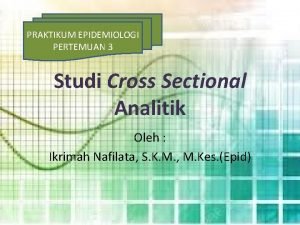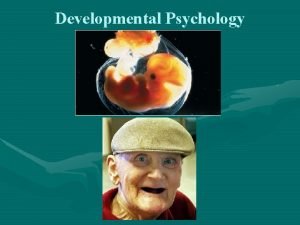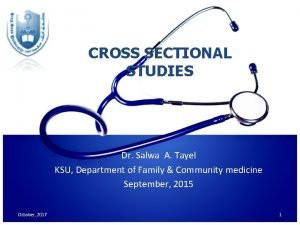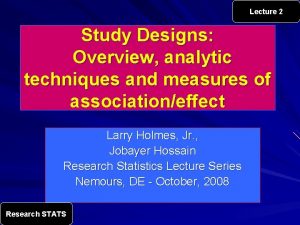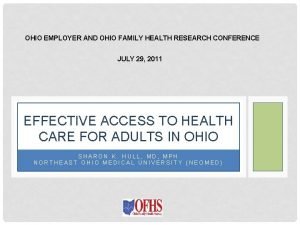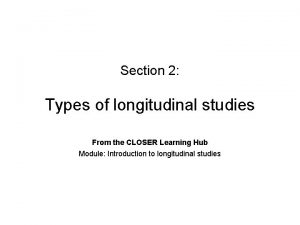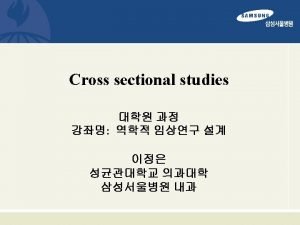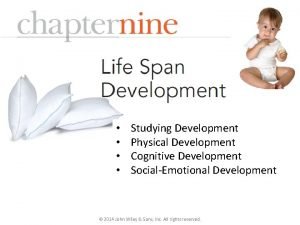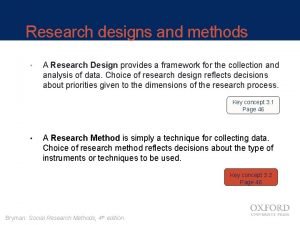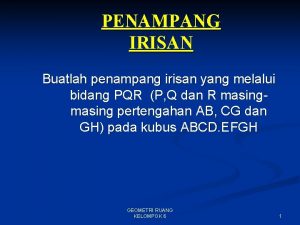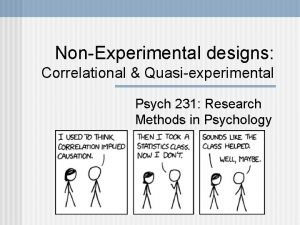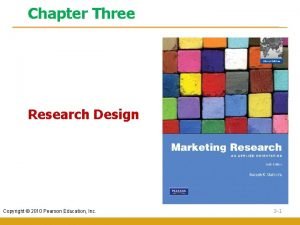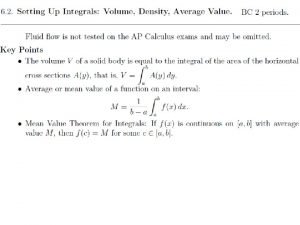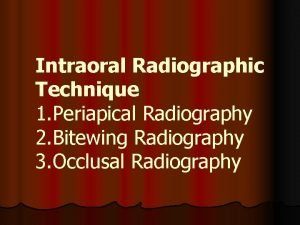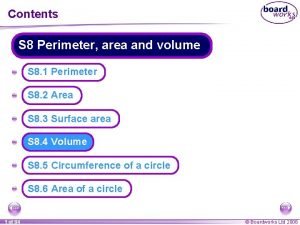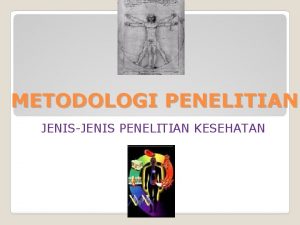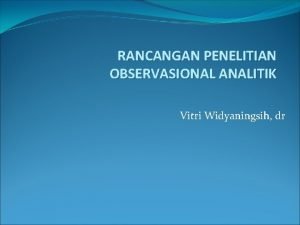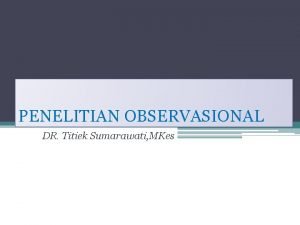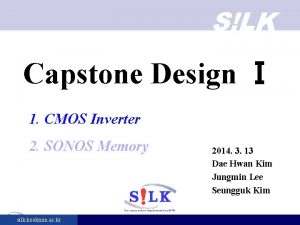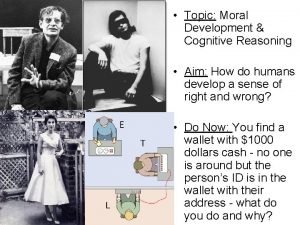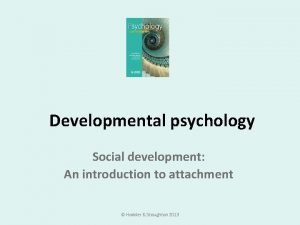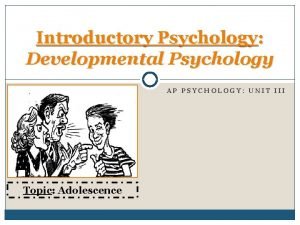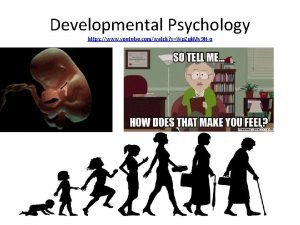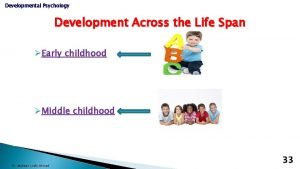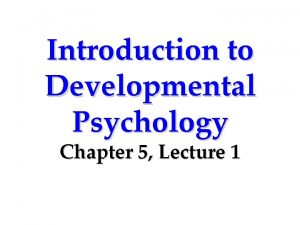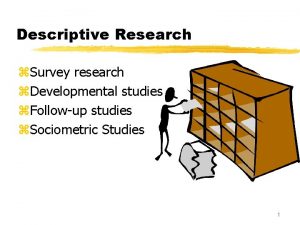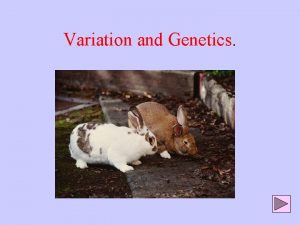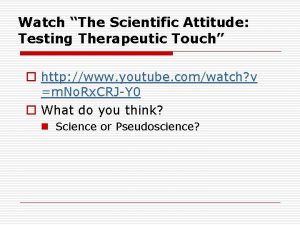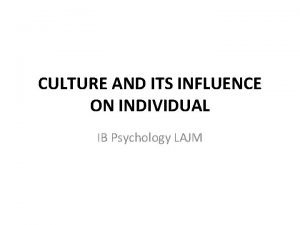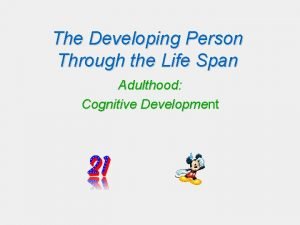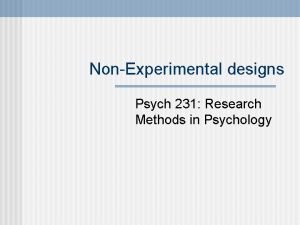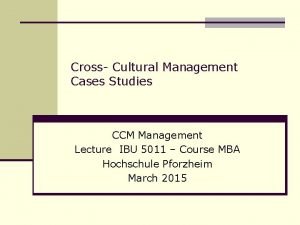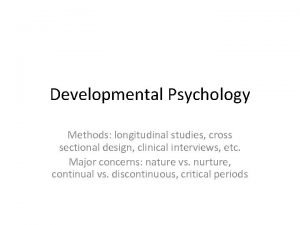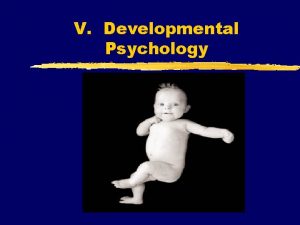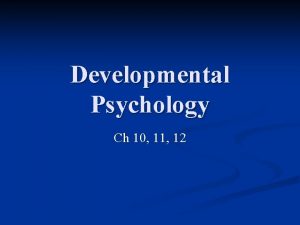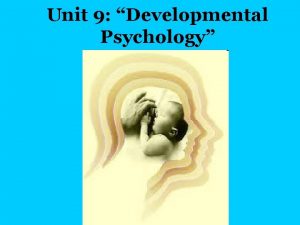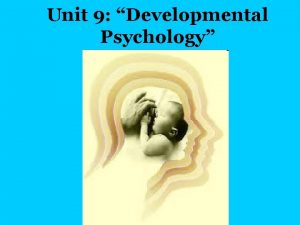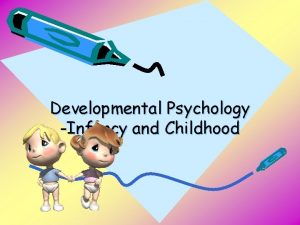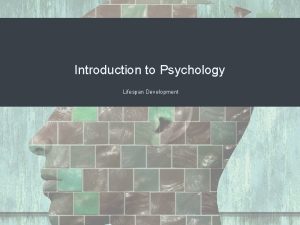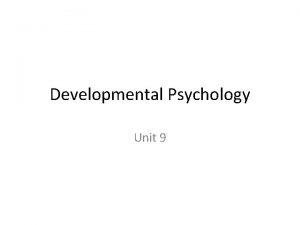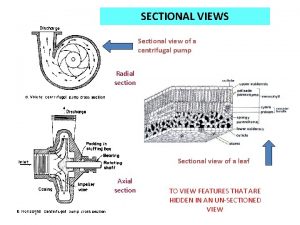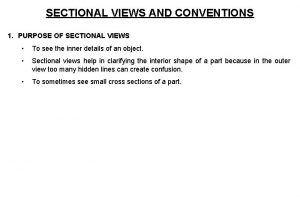Developmental Psychology Research Studies Cross Sectional Studies Study











































































- Slides: 75

Developmental Psychology

Research Studies Cross Sectional Studies ØStudy comparing development between age groups over relatively short period Longitudinal Study ØStudy tracing development of one age group over more extensive period

Developmental Psych • Study of physical, mental, and social changes over the life span. (Womb to tomb) • Focus is on 3 critical issues: ØNature / Nurture (Extent of influence) ØGradual, Continuous process (escalator), or sequence of stages? (rungs on a ladder) ØStability / change: Personality traits: Stay the same, or change over time?

Prenatal Development • One mature egg / 200, 000 sperm: The race begins…. • Conception to birth (9 months+) v. Zygote – fertilized egg begins cell division

Conception Union of Egg and Sperm (Egg-85, 000 x size of sperm!)

Prenatal Development Ø First week: zygote of 100 cells- begin to specialize in structure and function (from one original cell!) Ø 10 days: zygote implants to uterine wall (outer =placenta / inner = embryo) v. Genetic plan determines how all organs will form – differentiation – cells specialize (The great mystery…) v. By one month – millions of specialized cells v. By 6 weeks – organs form, heartbeat Ø Fetus – 8 th /9 th week (human form) • Somatic nervous system commands spontaneous movements (not felt by mom until about 16 th week) Ø 6 months: stomach functional, responsive to sound

Prenatal Development • 40 days 45 days 2 months(60) 4 months (120)

Prenatal Development • Placenta: screens out some potentially dangerous substances • Teratogens: toxic substances such as HIV, some drugs (nicotine & alcohol), can pass through placenta v. Fetal Alcohol Syndrome symptoms: mental retardation, poor motor coordination, impaired attention, and hyperactivity

Fetal Alcohol Syndrome Ø Leading cause of mental retardation: depresses activity in nervous systems)

Prenatal Development • Neurons grow at rate of 250, 000/minute! • By birth, infant has approx. 23 billion

Physical Development • Maturation v. Biological, universal growth processes / orderly changes in behavior vrelatively uninfluenced by experience vsets the basic course for development while experience adjusts it At birth 3 months 15 months Cortical Neurons

The Newborn ØWill turn towards mother’s voice ØHearing: dominant sense at birth ØVision: 8 to 12 inches ØPrefers sweet fluids

Newborns: Reflexes (Instincts) at birth • Rooting Reflex Øtendency to open mouth, and search for nipple when touched on the cheek • Grasping Reflex: Automatic grasping of objects placed in palm or toes • Sucking Reflex: Touch an object or nipple to the infant’s mouth and she’ll make rhythmic sucking movements • Moro Reflex: Hugging motion if startled or baby’s position changed

The Newborn Habituation… 80 Percentage of time spent looking 70 60 50 40 30 20 10 0 Familiar stimulus Novel stimulus

Habituation • Babies spend more attention on new stimuli / the more familiar, the less attention paid… • Method by which one studies a baby’s cognition ( measured by attention span)

Infancy: Neural Development • Until 18 months • Infantile Amnesia: No long-term memory prior to 3 ½ years / brain circuits not yet connected / process of maturation • By 4 yrs. , brain has nearly doubled • 3 -6 yrs: most rapid neural growth: frontal lobe • (Association areas: thinking, memory, language- last to develop) • Synaptic pruning – if not used then disconnect, but not destroyed

Attachment Theories • “What is learned in the cradle, lasts to the grave. ”

Social Development • Attachment Theories q. Traditional Theory: Infant attachment created through need for nourishment.

Harlow’s Monkey Experiments “Rethinking Attachment” • 1950’s-60’s • Early separation of infant monkeys • Soft baby blanket vs. wire cylinder with bottle • Result: v. Contact / touch critical for early attachment, emotional security

Harlow’s Experiment Surrogate Mother

Harlow’s Experiment

Origins of Attachment • Touch (Harlow) • Familiarity: Forms attachment v. Critical Period: Optimal period right after birth in which exposure creates proper development v. Imprinting: attachment based on first experience (gosling, chick, duckling) = “mother” / Fly Away Home

Erikson Parenting and Trust • Positive early parenting = basic trust • Basic trust = “world is predictable, reliable” • Basic trust as foundation for adult relationships

Mary Ainsworth: Attachment Study • Secure attachment (60% of infants) o comfortable in mother’s presence / Mother’s departure = initial distress / Mother’s return = seek contact • Insecure attachment o Cling to mother /Mother’s departure = extended distress or indifference / Return = cling or indifference Avoidance attachment o Indifferent to mother’s presence, departure, return Conclusion: Sensitive mothers / fathers = securely attached infants Studies isolating temperament confirmed parenting theory

Social Development § Harlow’s monkeys raised without touch showed extreme anxiety (fear) in novel situations throughout development

Social Development Percentage of infants 100 who cried when their mothers left 80 § Groups of infants left by their mothers in a unfamiliar room (from Kagan, 1976). Day care 60 40 Home 20 0 3. 5 5. 5 7. 5 9. 5 11. 5 13. 5 20 Age in months 29

Self-Concept The Developing Child • The Rouge Test: Self-Recognition (Video)

Parenting Styles 1. Authoritarian parents: impose rules and expect obedience. (Strict- “Because I said so. ” 2. Permissive parents: Few demands, little punishment- (submit to child’s demands / “Do your own thing. ”) 3. Authoritative parents: Demanding and responsive (Enforce and explain / justify the rules / Open discussion with teenagers / exceptions to rules…)

Research says… 1. Authoritarian = lower self-esteem, lower social skills 2. Permissive = more aggressive, immature 3. Authoritative= highest self-esteem, selfreliance, social competence 4. “Do you fit the description? ” Explain.

Remember “Correlation is not causation. ” Name any other variable that might be the cause of these results.

In conclusion… • Parenting (nurture) does matter in developing emotional well-being. • (“Genetics is not necessarily your destiny. ”)

Stage Theories in… Developmental Psychology

Theories on Cognitive Development • Jean Piaget: • 1999: Selected by Time Magazine as one 20 most influential scientists and thinkers of the 20 th century • British psychologist survey: named Piaget as the most influential psychologist of the 20 th century

Piaget and Cognitive Development • Paris: 1920’s • Theory of Child’s cognitive stages • intrigued by children’s wrong answers v. Traditional assumption: Child’s mind a miniature version of adult’s: “children simply know less” v. Piaget: Children reason in strongly illogical ways: thus think, reason differently than adults

Cognition • all mental activities associated with thinking, knowing, remembering or communicating

Schema: • Schema o Concepts (mental molds into which we pour experiences) • Identify / rationalize this picture. • What’s wrong with it? Why can’t we make sense of it?

Piaget’s Stages of Cognitive Development Typical Age Range Birth - 2 yrs About 2 to 6 yrs About 7 to 11 yrs About 12 thru adulthood Description of Stage Developmental Phenomena Sensorimotor Experiencing the world through • Object permanence senses and actions (looking, • Stranger anxiety touching, mouthing) Preoperational Representing things with words and images but lacking logical reasoning • Pretend play • Egocentrism • Language development • Conservation Concrete operational • Mathematical Thinking logically about concrete events; grasping concrete analogies transformations and performing arithmetical operations Formal operational Abstract reasoning • Abstract logic • Potential for moral reasoning


Sensorimotor Stage “A life lived, but not thought out. ” • • • Birth – 2 years (learning through senses, movement) Thinking at same speed as movment Object permanence (Piaget: 8 months) Ø Awareness that things continue to exist even when not perceived (hidden) • Stranger Anxiety (8 months) • Building Schema: Ø Assimilation: interpreting new experience in terms of existing schema (apply same concept to all things generally similar (Example? ) Ø Accommodation: Adapting schemas to incorporate new information (“Accommodate differences”)

Preoperational Stage • 2 yrs – 6/7 yrs ØUse of language Ø can’t perform operations of concrete logic

Preoperational • Key Ideas: ØSpeed of thinking increases / faster than movement ØAll objects have thoughts, feelings (“magical thinking) ØEgocentrism: Can’t perceive things from others’ point of view (to age 3) ØTheory of mind (age 4)– Understand another’s perspective / infer other’s feelings Ø 3 yr old: ØAutism: Impaired theory of mind…

Concrete Operational Stage • 7 yrs – 11 yrs • Logical thinking develops (concrete logic) • Conservation: “Quantity remains same despite changes in shape. ” (Volume, Area, Number) • Understand math transformation and conservation v 4+8=12 12 -4=8

Formal Operational Stage • • • 12 yrs thru adulthood From concrete to abstract thinking… Example: hypothesis testing, metaphors, analogies • “Not all adults use formal operations to the same degree, and some not at all. ” • Example: How would you be different if you were born on a planet that had no light?

Criticisms of Piaget’s Theory • Development seen as more continuous than Piaget’s stages • Much of his work based on studying his own three children! • Age associations are inaccurate (too late) o Example: 7 is too late for concrete operational ØStimulation at early age: education, computers etc.

Kohlberg’s Moral Stages of Development Postconventional Level (Self-defined morality) Morality of abstract principles: to affirm agreed-upon rights and personal ethical principles to gain approval or Conventional Level Early adolescence Preconventional Level Up to age 9 avoid Disapproval: Morality of law and social rules: Morality of selfinterest: to avoid punishment or gain concrete rewards § As moral development progresses, the focus of concern moves from the self to the wider social world.

In conclusion, • AS our thinking matures, so too does our morality… (Piaget +Kohlberg) • “Morality is not simply learned, but mentally constructed in sequential stages • Criticisms of Kohlberg: Ø Moral reasoning only (actions define morality, not thoughts) Ø Cultural bias: Chicago kids only…… ØCarol Gilligan: Bias towards women: men= justice / women = feelings of others (relational) • Morality: More Intuitive or Cognitive? – Social intuitionist: moral feelings precede moral thoughts – Moral action perspective: social influences to do the right thing

Erikson: Psychosocial Stages of Development • • Neo-Freudian Focus from sexual to social Life is conflict / struggle / stress sequence of social stages, each critical for personality development • Each stage presents conflict: personality needs vs. social demands = crisis, or turning point in development • Positive outcomes of past conflict = better chance of positive outcomes in future • (To some extent, stages are continuous)

Erikson’s Stages of Psychosocial Development Approximate age Stage Description of Task Infancy (1 st year) Trust vs. mistrust Based on need fulfillment- if needs are met, develop basic trust in world Toddler (2 nd year) Autonomy vs. shame Toddlers learn to exercise will and doubt do things for themselves, or they doubt their abilities. (“No!”) Preschooler (3 -5 years) Initiative vs. guilt Elementary (6 yearspuberty) Competence vs. Children’s work evaluated for 1 st timeinferiority compete against peers- feel confident or “inferiority complex” (School!) Preschoolers learn to initiate tasks and carry out plans, or they feel guilty about efforts to be independent. (From “no” to “why? ”)

Erikson’s Stages of Psychosocial Development Approximate age Stage Description of Task Adolescence (teens into 20’s) Identity vs. role confusion Teenagers main social task is to identify social identity- lack of success = identity crisis Young Adult (20’s to early 40’s) Intimacy vs. isolation Young adults struggle to form close relationships and to gain the capacity for intimate love, or they feel socially isolated. Middle Adult (40’s to 60’s) Generativity vs. stagnation The middle-aged discover a sense of contributing to the world, usually through family and work, or they may feel a lack of purpose. Late Adult (late 60’s and up) Integrity vs. despair When reflecting on his or her life, the older adult may feel a sense of satisfaction or failure. (Looking back…)

Introducing Adolescence…. 1. Pick three words (adjectives or nouns) that you think best describe your adolescent years.

Adolescence Introducing adolescence: 1. How do we define it? Ø Life between childhood and adulthood 2. What is it’s time frame? Ø Beginning of puberty, ending with adult independent status (teen years!) 3. How do we describe it? Ø “Stress and storm”

Adolescence and Physical Development ØPuberty § the period of sexual maturation § capable of reproduction

Physical Development § Primary Sex Characteristics § body structures that make sexual reproduction possible § ovaries--female § testes--male § external genitalia § Secondary Sex Characteristics § nonreproductive sexual characteristics § female--breast and hips § male--voice quality and body hair § Menarche (meh-NAR-key) § first menstrual period

Adolescence 1890, Women 10 7. 2 Year Interval 20 Age 1995, Women 12. 5 Year Interval 10 20 Age § In the 1890’s the average interval between a woman’s menarche and marriage was about 7 years; now it is over 12 years

Adolescence Height in centimeters 190 § Throughout childhood, boys and girls are similar in height. At puberty, girls surge ahead briefly, but then boys overtake them at about age 14. 170 150 130 110 90 70 50 0 2 Boys 4 6 8 10 12 14 16 18 Age in years Girls

Adolescence and Cognition • Piaget’s Stage? • Pruning (neural connections increase ‘til puberty) • Frontal Lobe: develops during teens • FL lags behind Limbic System (hormonal rage overrides logic = impulsive, risky actions (“stress and storm”) • Prefrontal Cortex: Last part of the brain to develop fully (executive decisions compromised)

Teenagers and Crime • Supreme court recently declared juvenile death sentences unconstitutional on basis of teen brains developmental immaturity

So, on the basis of what you know… • Should 16 year olds be able to drive?

The fact is…. • 1 in 5 16 yr. olds crash their car within the first year • 77% of fatal crashes by 16 yr. olds involve driver error • 16 yr. olds are involved in fatal crashes at 5 x the rate of drivers 20 yrs or older • 2/3 of Americans think 16 is too young (up from 50% in 1995)

Adolescence: Social Development § Identity § one’s sense of self § the adolescent’s task is to solidify a sense of self by testing and integrating various roles § Intimacy § the ability to form close, loving relationships § a primary developmental task in late adolescence and early adulthood

Adolescence: Social Development § The changing parent-child relationship Percent with positive, warm interaction with parents 100% 80 60 40 20 0 2 to 4 5 to 8 9 to 11 Ages of child in years

“The New Science of the Teenage Brain”, Nat. Geographic • The article proposes that the unique attributes of the adolescent can be explained by brain maturation and evolutionary psychology. • Build a specific case in defense of the irresponsible, impulsive adolescent based on the information discussed in the article. • Your focus should be brain maturation and evolutionary psychology. • Due in our next class.

Adulthood 1. Is there a “prime of life? ” If so, when…? Ø Ø Ø Physical peak in the early 20’s Most fertile in 20’s Cognitive abilities- little change through middle age (65 -75: significant decline) Ø Personal income: Peaks between 45 -54 (declines after 65) 2. 3. 4. 5. What age constitutes adulthood? What age constitutes middle age? What age constitutes old? Very old…? Do you associate old age more with condition, or years?

True or False? 1. Life satisfaction peaks in the fifties and then gradually declines after age 65. 2. Recognition memory- the ability to identify things previously experienced, declines with age. 3. Older people become more susceptible to short-term illnesses.

Adulthood: Physical Development • Sexual Reproduction • Women v. After 20’s: decline in fertility v 35 -39 yrs. (single intercourse = ½ chance of pregnancy compared to your 20’s) v. Menopause: end of menstrual cycle ØAround 50 ØDecrease of estrogen Øhot flashes (hormonal challenges)

Sexual Reproduction • Men ØNo cessation of fertility ØNo sharp decline in sex hormones ØGradual decline in sperm count / testosterone ØSexual drive / activity continues through life span (for men and women)

Sensory Development • Vision ØPupil shrinks, lens less transparent- reduces light reaching the retina (at 65, 1/3 light to retina than 20’s) Ø“Don’t you want a light on? ” • Hearing, smell and distance perception all slowly diminish

Adulthood: Physical Development § The Aging Senses 1. 00 0. 75 Proportion of normal (20/20) vision when identifying letters on an eye chart 0. 50 0. 25 0 10 30 50 Age in years 70 90

Adulthood: Physical Development § The Aging Senses 90 Percent correct when Identifying smells 70 50 10 30 50 Age in years 70 90

Adulthood: Physical Development § The Aging Senses 90 Percent correct when identifying spoken words 70 50 10 30 50 Age in years 70 90

Health • Aging = weakening immune system (more susceptible to disease (cancer / pneumonia) • Later adulthood = fewer short-term ailments (flu / colds • Neural processing gradually slows Ø Fatal driving accidents increase sharply after 75 (at 85, higher than 16!) • Brain cells- gradual loss- by 80, brain = 5% weight reduction • Women’s brain degenerates slower than men! • Exercise feeds the brain (oxygen helps form new cells and preserve neural connections)

Adulthood: Intelligence • Fluid Intelligence ØSpeedy abstract reasoning / very gradual decline after 20’s • Crystallized Intelligence ØKnowledge base / continues to expand through lifetime

Alzheimer’s • • • Dementia = mental erosion (memory, processing etc. ) Caused by decline of acetylcholine 3% of world population after age 75 Memory and then reasoning degenerates 5 to 20 years: emotionally flat to disoriented to incontinent to mentally vacant • 2 ailments in neurons: (diagnose before symptoms) Ø shriveled protein filaments in cell body Ø plaques (globs or degenerating tissue)

Adulthood: Dementia § Incidence of Dementia by Age Percentage with dementia Risk of dementia increases in later years 40% 30 20 10 0 60 -64 70 -74 65 -69 80 -84 75 -79 Age Group 90 -95 85 -89

Facing Death / Trauma • Elisabeth Kubler-Ross: On Death and Dying, 1969 q 5 Stages of Grief ØDenial ØAnger ØBargaining ØDepression ØAcceptance
 Studi cross-sectional adalah
Studi cross-sectional adalah 40 days baby in womb
40 days baby in womb Axis tool for cross sectional studies
Axis tool for cross sectional studies Cross sectional study
Cross sectional study Advantages of a cross sectional study
Advantages of a cross sectional study Prevalence ratio
Prevalence ratio Cross sectional research design
Cross sectional research design Bibliography of epidemiology
Bibliography of epidemiology Example for cross sectional study
Example for cross sectional study Limitations of cross sectional study
Limitations of cross sectional study Pengertian cross sectional study
Pengertian cross sectional study Classification of epidemiological studies
Classification of epidemiological studies Longitudinal design psychology
Longitudinal design psychology Serial the association
Serial the association Cross sectional and longitudinal research difference
Cross sectional and longitudinal research difference Cross sectional research design example
Cross sectional research design example Cross sectional research design
Cross sectional research design Research methods in developmental psychology
Research methods in developmental psychology Area of cross section of cuboid
Area of cross section of cuboid Section views
Section views Experimental vs non experimental
Experimental vs non experimental Irisan penampang
Irisan penampang Cross sectional vs longitudinal
Cross sectional vs longitudinal Cross-sectional correlational design
Cross-sectional correlational design What is quasi experimental research
What is quasi experimental research Cross sectional vs longitudinal
Cross sectional vs longitudinal Sphere cross sectional area
Sphere cross sectional area Dendritic drainage pattern
Dendritic drainage pattern Topographic occlusal projection
Topographic occlusal projection Cuboid area and perimeter
Cuboid area and perimeter Study types in medical research
Study types in medical research Cross sectional area of sphere
Cross sectional area of sphere Cross sectional
Cross sectional Sectional view examples
Sectional view examples It is the scattering of light
It is the scattering of light Vitri widyaningsih
Vitri widyaningsih Studi cross sectional
Studi cross sectional Kroseksional
Kroseksional Tabel cross sectional
Tabel cross sectional Cmos vil
Cmos vil Initiative vs guilt
Initiative vs guilt Lawrence kohlberg developmental psychology
Lawrence kohlberg developmental psychology Gestalt
Gestalt Attachment theory in psychology
Attachment theory in psychology Adolescent age range psychology
Adolescent age range psychology Devonte is a graduate student in developmental psychology
Devonte is a graduate student in developmental psychology Unit 3 developmental psychology
Unit 3 developmental psychology Clp 3143 ucf
Clp 3143 ucf Sublimimation
Sublimimation Psychology
Psychology Chapter 5 developmental psychology
Chapter 5 developmental psychology Developmental research design
Developmental research design Developmental descriptive research
Developmental descriptive research Test cross and back cross
Test cross and back cross Test cross and back cross with example
Test cross and back cross with example What does incomplete dominance mean
What does incomplete dominance mean Monohybrid cross vs dihybrid cross
Monohybrid cross vs dihybrid cross In the cross, in the cross be my glory ever
In the cross, in the cross be my glory ever Cross tooth cross arch balance
Cross tooth cross arch balance Paradigm shift from women studies to gender studies
Paradigm shift from women studies to gender studies Advantages of case studies in psychology
Advantages of case studies in psychology Acculturation ib psychology
Acculturation ib psychology Introspection methods of psychology
Introspection methods of psychology Positive psychology ap psychology definition
Positive psychology ap psychology definition Frustration aggression principle
Frustration aggression principle Social psychology ap psychology
Social psychology ap psychology Social psychology definition psychology
Social psychology definition psychology Health psychology definition ap psychology
Health psychology definition ap psychology Sequential vs longitudinal study
Sequential vs longitudinal study Cross sequential study
Cross sequential study Short case study on cross cultural management
Short case study on cross cultural management Outdoor and environmental studies study design
Outdoor and environmental studies study design Legal studies study design
Legal studies study design Theatre studies study design
Theatre studies study design Vcaa psychology study design
Vcaa psychology study design Snapshot study psychology
Snapshot study psychology
